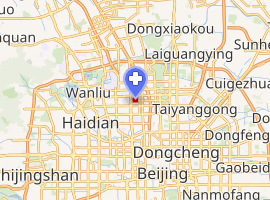Peking University Third Hospital
Peking University Third Hospital (PUTH, Chinese: 北京大学第三医院) was founded in 1958 under the supervision of the Ministry of Health. It is affiliated with Peking University including 36 clinical departments and 1,752 clinic beds.[1] The hospital is a combination of medical services, medical education/teaching, research and prevention as well as health care, comprehensive hospital in the first-rate of three levels that set by China government.
| Peking University Third Hospital | |
|---|---|
.jpg) | |

| |
| Geography | |
| Location | 49 Huayuan North Road, Huayuanlu Subdistrict, Haidian District, Beijing, China |
| Organisation | |
| Type | Teaching |
| Affiliated university | Peking University |
| Services | |
| Emergency department | Yes |
| Beds | 1,264 |
| History | |
| Opened | 1958 |
| Links | |
| Website | www |
| Lists | Hospitals in China |
Overview
.jpg)
It is a designated hospital which served the Olympics 2008, with a staff then of 2,295. It has 1,752 clinic beds and 36 clinic departments. Its Reproductive Medicine Center is not only the earliest founded but also the largest center in Asia; its Spinal Surgery Department is the strongest in China mainland, and is the only center designated for treatment of sports people by the Chinese Olympic Committee. Its Cardiology Department is in an advanced position in China, and has the key lab for molecular cardiology of the China education department. It specializes in Ophthalmology, Digestion Medicine, treatment for early stage Gastric Cancer, Plastic Surgery and Occupational Diseases and is among the top in China.
Peking University Third Hospital has been equipped with much sophisticated equipment;- CT, SPECT, MRI, new vascular angiography, stereo angiography, color Doppler for heart, abdominal color ultra sound electronic video camera, ultra sound endoscope, external stone crusher, isotope renography, autobiochemistry analysis machine, radio-immunity test instrument, renal dialysis and a laser treatment machine. This advanced equipment is playing a more and more important role in examining and curing various common and complicated diseases.[2]
The hospital plays a very important role in teaching as well. Its teaching tasks include Clinical Medicine, Pharmacy, Nursing, Lab Medicine and Preventive Medicine. It also trains a huge number of post-graduates and medical observers. Its 15 departments are assigned training tasks for general medical specialists in Beijing, and 11 departments for a sub-specialist training base.
Scope of service
Clinical departments:
- Cardiology Department
- Respiratory Medicine Department
- Endocrinology and Metabolism Department
- Nephrology Department
- Hematology Department
- Gastroenterology Department
- Rheumatology and Immunology Department
- Geriatrics Department
- Neurology Department
- Infectious Diseases Department
- Emergency Department
- Dermatology Department
- Traditional Chinese Medicine Department
- Occupational Disease Department
- Radiation Oncology Department
- Pediatrics Department
- General Surgery Department
- Orthopaedic Department
- Plastic Department
- Urology Department
- Thoracic surgery Department
- Critical Care Medicine Department
- Neurosurgery Department
- Interventional Radiology and Vascular Surgery Department
- Gynecology and obstetrics Department
- Institute of Sports Medicine
- Rehabilitation Medicine Department
- Critical Care Medicine Department
- Reproductive Medicine Center
- Ophthalmology Department (Eye Center)
- ENT Department
- Stomatology Department
Medical technology departments:
- Ultrasound Diagnosis Department
- Nuclear Medicine Department
- Radiology Department
- Blood Transfusion Department
- Pharmacy Department
- Laboratory Medicine Department
- Pathology Department
- Medical Record Departmentment
- Operation Theatre
- Clinical Nutrition Department
External divisions
- The C.P.C. Central Committee Party School Branch Of Peking University Hospital
- The Second Clinic Of Peking University Third Hospital
References
- "医院简介" (in Chinese). Peking University Third Hospital. Archived from the original on 25 December 2016. Retrieved 24 December 2016.
- University Third Hospital Introduction in Monash University website